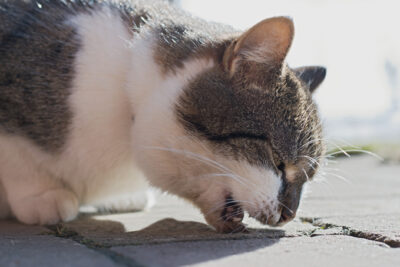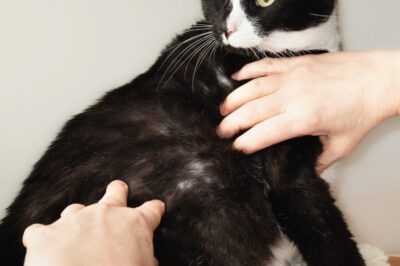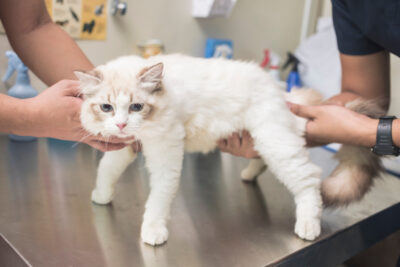Cat Ear Infection: 6 Symptoms to Watch For

Overview
All featured products are chosen at the discretion of the GreatPetCare editorial team and do not reflect a direct endorsement by the author or reviewer.
Cat ears are super cute – little perky triangles sticking up off their cute little heads. Cats express themselves with their ears, laying them flat when scared or swiveling them to and fro when they hear an unusual noise.
But cat ear infections can cause discomfort and pain, and it may not be obvious from the outside that your cat is suffering. Read this article to understand the inside of cat ears more thoroughly, and the typical symptoms of an ear infection.
Understanding Cat Ear Anatomy
Your cat’s ear is made of multiple parts. These include the:
- Pinnae
- Ear canal
- Tympanum (ear drum)
- Middle ear
- Tympanic bulla
- Internal ear
- Cochlea
- Vestibular system
The pinnae is the part of a cat’s ear that you can see – the cute triangles that stick out from your cat’s head. The ear canal itself is L-shaped. There is a vertical canal (the tall part of the “L”) and the horizontal canal (the flat part of the “L”). The vertical canal can be seen by looking into the opening at the base of your cat’s pinna. The horizontal canal cannot be seen without the use of an otoscope.
At the bottom of this canal is the tympanum, or ear drum. Behind it is the middle ear, a small open cavity that is typically filled with air. The bone around the middle ear is called the tympanic bulla and is the round smooth protuberance just behind and below your cat’s pinna. Next to this is the internal ear, which contains the organ for hearing (cochlea) and the system of fluid-filled canals responsible for balance (vestibular system).
Cat ear infections most commonly affect the vertical and horizontal canal, and this is known as an external ear infection or otitis externa. Infections can occur in the middle ear as well and are known as otitis media. Internal ear infections are very difficult to diagnose – essentially, veterinarians can only diagnose based on the symptoms your cat has.
Causes of Cat Ear Infections
Approximately half of all external ear infections are due to ear mites, specifically Otodectes cynotis. The next most common cause is hypersensitivity such as an allergy to food, the environment, or something your cat comes into contact with like certain medications.
Other possible causes include:
- Parasites other than ear mites, such as Demodex mites
- Foreign bodies, i.e. things that shouldn’t be in the ear such as grass
- Skin disorders such as seborrhea (white scaly skin disease)
- Immune-mediated disorders such as vasculitis
- Glandular disorders such as ceruminous cystomatosis
- Proliferative necrotizing otitis of cats (rare)
Symptoms of Ear Infections in Cats

With mild ear infections, pet parents may never notice symptoms in their cats – even if it itches, cats are very discrete in their scratching and grooming habits. Most cats, however, will develop symptoms.
Symptoms of ear infections in cats include:
- Redness in the canals
- Discharge in the canals
- Frequent head shaking or head bobbing
- Frequent scratching of the ears
- Fur loss and abrasions on or around the base of the ears (due to scratching)
- Swelling, crust, or redness of the pinna
If your cat also has inflammation of the inner ear, you may notice your cat stumbling and walking drunkenly, which is called ataxia. In middle ear infections, the nerve that controls one side of the face may be affected, preventing your cat from blinking on one side or making the face look like it has two different sides.
Diagnosing Cat Ear Infections
Veterinarians diagnose external ear infections by looking inside the ears for inflammation. Cytology is a common test, which involves taking a small sampling of the debris in an ear to smear on a slide, stain it, and look under the microscope. The type of medication used to treat secondary infections in the ears will depend on what infectious agents veterinarians see. Parasites, yeast, and bacteria are diagnosed this way.
To diagnose middle ear infections, veterinarians will attempt to look deep inside your cat’s ear canal with an otoscope. Looking at the eardrum can help diagnose middle ear infections but it isn’t always apparent. If the ear is very inflamed or painful, they may not be able to see the eardrum without sedation. X-rays of the bullae, or bones of the middle ear, can help with diagnosis.
To diagnose inner ear infections, veterinarians assume it is present if your cat has ataxia and also a middle ear infection.
Treating Cat Ear Infections
Cat ear infections are treated first and foremost by cleaning out the ears. If waxy debris is trapped inside, medication cannot reach the entire ear. However, cleaning too vigorously could irritate the ear or worsen the infection, so this task is best left to your veterinarian. In severe cases, they may sedate your cat to thoroughly clean the ears.
Next, your veterinarian will recommend medication to treat the ear infection, as well as any pain or inflammation. Depending on the type of infection, the treatment may be a combination of antibiotic, antifungal, and/or anti-inflammatory medicines.
In cases of external ear infections, your vet may prescribe a topical medication, like ear drops, ointment, gel, or cream. These are often applied into the ear canal for a week or more.



In cases where the middle or inner ear is severely infected or your cat is experiencing chronic infections, your vet may opt for oral or injectable medications. For bacterial infections, your vet may prescribe an antibiotic like Clavamox or Baytril. For fungal infections, an antifungal medication like Itrafungol is often used. Steroids may be given if swelling or inflammation is intense.



Additional treatment may be required, depending on what’s causing the ear infection. If ear mites are the culprit, your veterinarian will recommend a monthly parasite preventative to rid your cat of pests and prevent chronic infections. These are typically topical treatments, like Revolution Plus or Advantage Multi that you apply to the skin on the back of the head to fight fleas as well as a variety of parasites for an entire month.


If an allergy is causing ear infections, your veterinarian may prescribe a prescription diet for food allergies or medication such as Atopica to help reduce the inflammation that environmental allergies can trigger.



Treating secondary infections, or infections of bacteria and yeast that did not cause the original inflammation in the ear, is only half the battle. The most common reason for secondary infections is because ear mites are present. If parasites are found, a topical treatment is often applied to the skin on the back of the head that fights fleas as well as a variety of parasites for an entire month. If an allergy is causing ear infections, your veterinarian may prescribe a prescription diet for food allergies or medication such as antihistamines to combat environmental allergies.
Antibiotics by mouth (oral) or injection are not very useful in ear infections, as medication given these ways does not get into the ear very well. However, in cases of middle ear and inner ear infections, antibiotics are frequently used due to the severity. Steroids orally or by injection may be given if swelling or inflammation is intense.
Home Remedies for Cat Ear Infections
There are no home remedies that will eliminate infections such as bacteria, yeast, or parasites.
Mixing a solution that is 1/4 to 1/2 white vinegar with water could be used to clean the ears if your cat has a history of yeast infections. However, vinegar and water do not dry easily, and moist environments can lead to worsening of infections. Also, it does not combat infections as well as commercial ear cleansers.
Using commercial cat ear cleansers that have antibacterial, antifungal, and drying properties once or twice per week will decrease infection and prevent it in the future.



Many cats – around 40 percent – develop ear infections due to hypersensitivities, which is commonly linked to a food allergy. For this reason, focusing on a novel protein diet may help prevent ear infections. Novel protein diets are complete and balanced diets that contain a single type of meat that your cat has never had before. A home-cooked diet is incredibly dangerous for cats if not prescribed by a veterinary nutritionist, as finding the right balance of amino acids and minerals is critical and requires specific supplements.
How to Prevent Cat Ear Infections

For cats who live with many other cats or go outside – even if just on your porch – monthly flea topical medication that also prevents ear mites is best. If your cat develops a couple ear infections and parasites are not involved, preventing the allergy with a novel protein diet, avoiding contact with specific medications, and giving antihistamines or other therapies for reducing environmental allergies will help prevent ear infections.
Regular weekly cleanings of your cat’s ears with an ear cleanser that is antibacterial, antifungal, and has drying properties will prevent future ear infections. Squirt the solution into the ear canal until you see the canal is full, massage the base of your cat’s ear several times, then allow your cat to shake it out. You can gently wipe around the pinnae of your cat’s ear with cotton gauze to get rid of debris.









